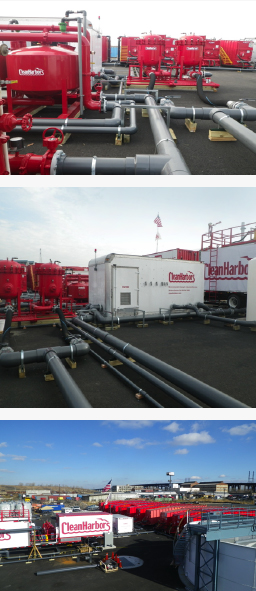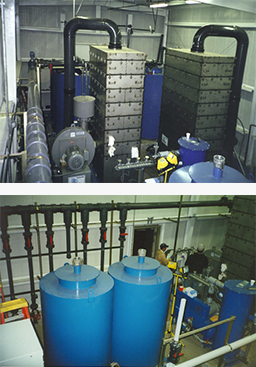Remediation System Construction and Installation
Clean Harbors Remediation Technologies provide a full range of solutions when the need arises for mobile or permanent system construction. With more than 20 years of experience, our reputation is strengthened every day by offering clients the finest equipment and proven technical service.
We offer pre-built custom mobile units and full-scale permanent water and soil treatment plants. Some of our systems are still in operation after 10 to 15 years of continuous operation. Our engineering and technical staff have designed and built a countless number of remediation systems, employing the following technologies:
- Air Sparge
- Soil Vapor Extraction
- NAPL Recovery
- Oil / Water Separation
- Advanced Oxidation
- Multi-Phase Extraction
- Air Stripping
- Catalytic and Thermal Oxidizers
For more information about specific installations we have conducted, continue reading below.
CASE STUDY – Multi-Phase Extraction Systems (MPE)
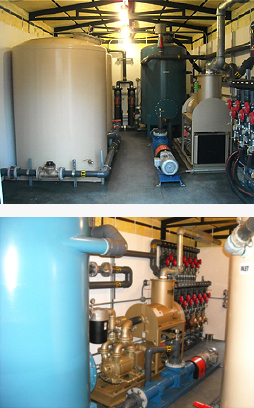 Location: Upper Michigan
Location: Upper Michigan
Project Value: $600,000.00
This MPE system was intended to reduce the concentrations of free product, dissolved phase contaminants, and vaporphase contaminants.
An explosion-proof Dekker 400 cfm liquid ring pump (LRP) provides vacuum to the system, at a minimum required 12 inches of mercury (Hg”). The LRP simultaneously removes liquids and vapors via 23 multi-phase extraction wells (MPE). The majority of the wells are designed with a stinger line for liquids recovery and a separate line for vapor recovery. The pump is set to operate within the range of 14 -20” Hg, controlled by a 4-20 mA output to a VFD. A 1,039-gallon knockout tank is installed between the LRP and the MPE wells. This tank serves as a separator for recovered vapors and liquids. The tank is equipped with conductivity sensors to trigger on/off operation of the transfer pump, as well as emergency shut-down of the system.
A Moyno 2000 progressive cavity pump serves as the transfer pump for removing liquids from the knockout tank. Liquids transferred from the knockout tank will first receive sediment filtration using two 100-micron bag filters. From there, the liquids receive treatment through two 3,000 lb GAC vessels set in a lead/lag configuration. The system is set up with a 12 valve header system to facilitate back flushing and changes in lead/lag configuration.
Vapors collected by the LRP will pass through a heat exchanger designed to keep the process air temperature at approximately 90 degrees. The heat exchanger is controlled via a variable frequency drive (VFD). From there, vapors will be treated using two 3,000 lb GAC vessels set in a lead/lag configuration.
CASE STUDY – Landfill Leachate Collection and Treatment System
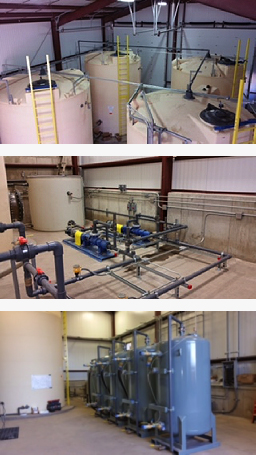 Location: Allegheny County, Pennsylvania
Location: Allegheny County, Pennsylvania
Project Value: $3.2 Million
The source of the contaminated leachate was a nearby facility that manufactured hydrocarbon-based resin products for the adhesive and rubber industries. Wastes generated during the manufacturing process consisted primarily of clay poly and dechlor cake slurry which are composed of petroleum and coal-derived chemicals mixed with clay. Other wastes included organic solvents, resin cakes, filter materials, and oils. The primary constituents of concern are benzene, toluene, ethylbenzene, and xylene (BTEX), naphthalene, styrene, tri-methyl benzene (TMB) and 2-methylnaphthalene.
Clean Harbors Remediation Technologies was contracted to assist with the design and installation of the entire leachate collection and treatment plant including site grading, installation of two 60 x 100’ buildings, all electrical systems and instrumentation, piping, and all water treatment system components. The current system consists of the following:
- A 200 ft long, six-inch diameter stainless steel collection pipe designed to send leachate from the collection sump to the treatment plant.
- Raw leachate enters a 20 gpm coalescing plate-type oil-water separator (OWS). The OWS includes vapor phase (VP) granulated activated carbon (GAC) filters to manage odors.
- The separated oil phase flows to a 400-gallon steel tank, which is integral to the OWS and periodically emptied and transported off-site for proper disposal or recycling.
- The aqueous stream gravity flows to a 200-gallon equalization tank prior to being pumped through the polishing system. The polishing system consists of two 25-micrometer (µm) bag filters in parallel, two 400-pound organoclay vessels in series, and two 700-pound GAC vessels in series. Effluent from the polishing system gravity flows through a two-inch hose and normally open valve to a discharge vault. Treated effluent gravity drains from the discharge vault through a two-inch pipe to a manhole near the entrance to the site, which is the connection to the Jefferson Hills sanitary sewer.
The system is comprised of a number of control and monitoring devices including:
- A programmable logic control (PLC) with a clone that sends and receives signals from the field devices and communicates via short message service (SMS) remotely to system operators.
- A restrictor plate, which consists of a 1-inch diameter steel orifice plate, is installed immediately upstream of the OWS to limit the flow during storm events.
- An automated isolation valve is installed immediately upgradient of the restrictor plate that closes in response to a high level in the OWS and/or a high level in the equalization tank.
- A series of two supplemental storage tanks which take overflow leachate from upstream of the OWS when the isolation valve is closed. The tank volumes are 6,900 gallons and 17,600 gallons, respectively, and are plumbed in series. The total supplemental storage capacity for untreated leachate is approximately 24,500 gallons. A 500-gallon storage tank takes the overflow from the equalization tank in the event of high flow.
- High and low-level alarms in the OWS alert the operators of these levels.
- High and low-level switches in the equalization tank that operate the transfer pump with the pump turned on at the high-high level and off at the low level.
- A flow meter that monitors the flow rate and total volume of treated leachate entering the municipal sewer system.
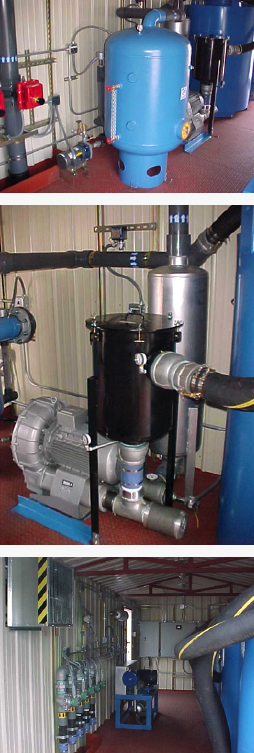 CASE STUDY – Soil Vapor Extraction and Air Sparging
CASE STUDY – Soil Vapor Extraction and Air Sparging
Location: Mid-Michigan
Project Value: $500,000.00
Clean Harbors Environmental Services (CHES) was contracted for the construction of a groundwater remediation system at the Village of Douglas in Allegan County, Michigan. Soil and groundwater had been contaminated due to a release of volatile organic compounds (VOCs) and semi-volatile organic compounds (SVOCs) and metals. The main contaminant of concern is Trichloroethene (TCE). Air sparge, in conjunction with a soil vapor extraction (SVE), was selected as the best course of treatment by the design engineer.
The system consists of perpendicular intersecting lines of air sparge and vapor extraction points installed in the source area. Each SVE and sparge header had its own blower and control mechanisms consisting of temperature and pressure gauges, sample ports and adjustable valves to control flow rates. The system is equipped with a programmable logic control (PLC) used to trigger alarm conditions and remote notifications.
The off-gas from the system is treated with granular activated carbon units. Condensate from the air sparge and SVE system is returned to the subsurface within the plume via an up-gradient injection well. CHES provided all labor, equipment, and materials for the construction of the remedial system. The scope of work is summarized as follows:
CHES installed 14 air injection points. and nine vapor extraction points. CHES then used directional drilling/trenching from each sparge injection point/vapor recovery line to connect back to the treatment building. CHES completed the construction of the system which houses the air sparge and SVE treatment system components, including the air sparge compressor, vapor recovery blower and associated piping.
Manifolds were built within the treatment trailer for the sparge lines and vapor recovery lines (including ball valves, flow meters, gauges, etc.). A weather-proof heat exchanger and two 1,000-pound capacity, weather-proof, vapor phase carbon vessels for final air-polishing were installed. CHES installed all controls for compressor and blower operation, including controls that shut off the sparge compressor upon shut off of the vapor recovery blower. Complete site restoration was completed last, including the replacement of removed concrete or asphalt surfaces.
CASE STUDY – Wastewater Treatment for River Dredging and Sediment Processing
Location: Passaic River New Jersey
Project Value: $4,200,000.00
Clean Harbors was contracted to provide environmental services involving the construction and operation of a treatment system for water generated during river bed dredging for an EPA-mandated removal of hazardous and non-hazardous impacted sediment.
The water treatment system received water from the sediment processing stage, treating up to 1 MGD, and discharging treated water back into the Passaic River. The treatment system includes a primary settling clarifier equipped with chemical treatment, filtration, filter bag screening and activated carbon stages.
The system is monitored and controlled via PLC receiving input from multiple flow meters, level transmitters, VFD-controlled pumps, pressure sensors and turbidity monitors.
Powered with multiple pumps which are mounted in fully enclosed buildings, the entire system is controlled by a master control room equipped with pump drives, PLC and a touch screen panel view for system monitoring and control. All system control, pumps and electrical distribution components were constructed and installed in three separate skid-mounted buildings and tested at our Water Treatment and Carbon Treatment Technology facility located in Kalkaska, MI.
The system was designed and built to meet all the customer’s NJPDES permit requirements for discharge while minimizing the cost of operation. The treatment system operated 24 hours/day, six days per week. Clean Harbors has provided our customers with experienced staffing and industry-proven equipment to construct the water treatment system and will continue providing services to successfully execute the operation of the wastewater treatment system in 2012.
CASE STUDY – Groundwater and Soil Remediation using SVE and Air Strippers
Location: Mid-Michigan
Project Value: $ 1.2 Million
Clean Harbors was contracted by an environmental consultant working on behalf of the state of Michigan to construct and operate a remediation system designed to treat soil and groundwater impacted by chlorinated hydrocarbons. The source of the contamination was a dry cleaning facility. Clean Harbors installed the following equipment and extraction network at this site:
- Five extraction wells, submersible pumps, and 6,000 linear feet of 6-inch HDPE force main.
- Two SVE cluster wells were installed, along with 650 feet of 4-inch piping to the building.
- Two 300 gpm / 900 cfm 7-tray air strippers were installed to process water. Four 1,500 lb carbon vessels were used as a polish for the water.
- The SVE vapor stream was collected using one 10 horsepower blower, drawing 50 inches of water column. SVE vapors were treated using two 1,500 lb carbon vessels.
- The entire installation was managed and performed by Clean Harbors including the installation of wells, pumps, flow lines, building construction, equipment installation, and electrical.
- The entire installation was completed in 58 days.
Please feel free to contact us at any time regarding our Remediation Services. For our Michigan offices call (989) 875-6500. For our New Jersey office call (231) 357-9033.


